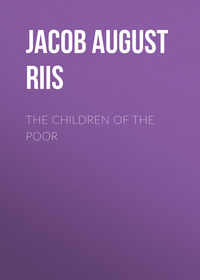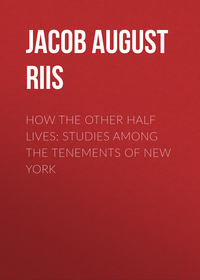 полная версия
полная версияThe Battle with the Slum
16
Report of Tenement House Commission, 1900.
17
Tenement house census of 1900: Manhattan and the Bronx boroughs (the old city), 46,993 tenements, with a population of 1,701,643. The United States census of the two boroughs gave them a population of 2,050,600. In the Greater New York there are 82,000 tenements, and two-thirds of our nearly four millions of people live in them.
18
Police census of 1900, block bounded by Canal, Hester, Eldridge, and Forsyth streets: size 375 × 200, population 2969, rate per acre 1724. Block bounded by Stanton, Houston, Attorney, and Ridge streets: size 200 × 300, population 2609, rate per acre 1894.
19
There is an advanced outpost of blacks as far up as One Hundred and Forty-fifth Street, but the main body lingers yet among the sixties.
20
That was, however, a reduction of 236 since 1898, when the census showed 2379 rear houses.
21
Report of Gilder Tenement House Commission, 1894.
22
"Municipal Government in Continental Europe," by Albert Shaw.
23
Report of the Tenement House Committee of 1900. The secretary of that body said: "Well might those maps earn for New York the title of the City of the Living Death."
24
Report of Tenement House Commission of 1900.
25
"The Making of an American."
26
Since reading this proof I have been over and verified my diagnosis. The trouble must have been with me. The soup and the mutton and the pie had each its proper savor, and the cook is all right. So is the lunch. There is no fifty-cent lunch in the city that I know of which is better.
27
Superintendent Maxwell in Municipal Affairs, December, 1900.
28
According to the register of the United Hebrew Charities, between October 1, 1884, and June 1, 1902, the number was 539,067, and it is again on the increase. The year 1902 will probably show an increase in this class of immigration over 1901 of quite 15,000.
29
The following is the declaration of principles of the National Consumers' League:—
30
The following is from the New York Herald of April 8, 1902: One of the strangest sandwich complications so far recorded occurred in a saloon in Columbia Street, Brooklyn, on Sunday. A boy rushed into the Amity Street police station at noon, declaring that two men in the saloon were killing each other. Two policemen ran to the place, and found the bartender and a customer pummelling each other on the floor. When the men had been separated the police learned that the trouble had arisen from the attempt of the customer to eat the sandwich which had been served with his drink. The barkeeper objected, and, finding remonstrance in vain, resorted to physical force to rescue the sandwich from the clutches of the hungry stranger. The police restored the sandwich to the bartender and made no arrests.
31
In the first Greater New York election.
32
"Year-Book of Elmira State Reformatory," 1901. The statistics deal with 10,538 prisoners received there in twenty-seven years. The social stratum whence they came is sufficiently indicated by the statement that 15.96 per cent were illiterates, and 47.59 percent were able to read and write with difficulty; 32.39 per cent had an ordinary common school education; 4.06 per cent came out of high schools or colleges.
33
Mrs. A. A. Anderson.
34
June 26, 1901.
35
The name bestowed upon it by the older toughs before the fact, not after.
36
To be sure, it did nothing else. When the people asked for $5000 to fit up one playground. Mayor Van Wyck replied with a sneer that "Vaudeville destroyed Rome."
37
Up to June, 1902.
38
After two attempts that were not shining successes, the politicians at Albany and New York calmly dropped the matter, and for four years ignored the law. The Superintendent of Schools is at this writing (June, 1902) preparing to have the police take the child census, without which it is hard to see how he can know the extent of the problem he is wrestling with. Half-day classes are a fair index of the number of those anxious to get in; but they tell us nothing of the dangerous class who shun the schools.
39
On May 31, 1902, there were 10,036 class teachers in elementary schools in the Greater New York, exclusive of principals and the non-teaching staffs, and of the high school teachers. With these, the total number was 11,570, with a register of 445,964 pupils.
40
The managers of the New York Public Library have found a way, and have maintained twenty-seven home libraries during the past year (1901): little cases of from fifteen to forty books entrusted to the care of some family in the tenement. Miss Adeline E. Brown, who is in charge of the work, reports a growing enthusiasm for it. The librarian calls weekly. "We come very near to the needs of these families," she writes, "the visit meaning more to them than the books. In nearly every case we allow the books to be given out at any time by the child who glories in the honor of being librarian. In one wretched tenement, on the far East Side, we are told that the case of books is taken down into the yard on Sunday afternoon, and neighbors and lodgers have the use of them." It is satisfactory to know that the biggest of the home libraries is within stone's throw of Corlear's Hook, which the "Hook Gang" terrorized with rapine and murder within my recollection.
41
On the day it was published the newspapers reported the killing in the streets of three children by trucks.
42
The Astor, Lenox, and Tilden foundations represent a total of some seven millions of dollars. The great central library, erected by the city, is to cost five millions, and the fifty branches for which the city gives the sites and Andrew Carnegie the buildings, $5,200,000. The city's contribution for maintenance will be over half a million yearly.
43
The first year's record was 186 lectures and 22,149 hearers. Last winter (1901-1902) there were 3172 lectures in over 100 places, and the total attendance was 928,251. This winter there will be 115 centres. It is satisfactory to know that churches and church houses fall in with the plan more and more where there are no schools to serve as halls.











